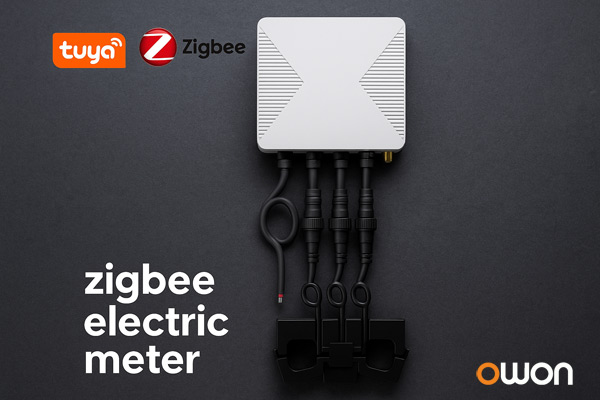Zigbee Electric Meters Demystified: A Technical Guide for Smart Energy Projects
As the energy industry continues to move toward digital transformation, Zigbee electric meters have become one of the most practical and future-proof technologies for smart buildings, utilities, and IoT-based energy management. Their low-power mesh networking, cross-platform compatibility, and stable communication make them a preferred choice for both residential and commercial projects.
If you are a system integrator, energy solution developer, OEM manufacturer, or B2B buyer, understanding how Zigbee metering works—and when it outperforms other wireless metering technologies—is essential for designing scalable and reliable energy systems.
This guide breaks down the technology, applications, and integration considerations behind Zigbee electric meters to help you make informed decisions for your next energy project.
1. What Exactly Is a Zigbee Electric Meter?
A Zigbee electric meter is a smart metering device that measures electrical parameters—voltage, current, active power, power factor, and import/export energy—and transmits the data over the Zigbee 3.0 or Zigbee Smart Energy (ZSE) protocol.
Unlike WiFi-based meters, Zigbee meters are purpose-built for low-latency, low-power, and high-reliability communication. Their benefits include:
-
Mesh networking with long-distance hop communication
-
High device capacity (hundreds of meters on a single network)
-
Greater stability than WiFi in crowded RF environments
-
Strong integration with smart home and BMS ecosystems
-
Long-term reliability for 24/7 energy monitoring
This makes them ideal for large-scale, multi-node deployments where WiFi becomes too congested or power-hungry.
2. Why Global B2B Buyers Choose Zigbee Utility Meters
For B2B customers—including utilities, smart building developers, energy management companies, and OEM/ODM clients—Zigbee-based metering offers several strategic advantages.
1. Scalable and Reliable Multi-Node Mesh Networks
Zigbee automatically forms a self-healing mesh network.
Every meter becomes a routing node, expanding communication range and stability.
This is essential for:
-
Apartments and condominiums
-
Smart hotels
-
Schools and campuses
-
Industrial facilities
-
Large energy monitoring networks
The more devices added, the more stable the network becomes.
2. High Interoperability With Gateways and Ecosystems
A Smart Meter Zigbee device integrates seamlessly with:
-
Smart home gateways
-
BMS/EMS platforms
-
Zigbee hubs
-
Cloud IoT platforms
-
Home Assistant via Zigbee2MQTT
Because Zigbee follows standardized clusters and device profiles, integration is smoother and faster than many proprietary solutions.
3. Low Energy Consumption for Long-Life Deployments
Unlike WiFi-based metering devices—often requiring more power and bandwidth—Zigbee meters operate efficiently even in large networks of hundreds or thousands of meters.
This significantly reduces:
-
Infrastructure cost
-
Network maintenance
-
Bandwidth usage
4. Suitable for Utility-Grade and Commercial Metering
Zigbee Smart Energy (ZSE) supports:
-
Encrypted communication
-
Demand response
-
Load control
-
Time-of-use data
-
Billing support for utility applications
This makes ZSE-based Zigbee utility meters highly suitable for grid and smart city deployments.
3. Technical Architecture of Zigbee Energy Metering
A robust Zigbee energy meter combines three major subsystems:
(1) Metering Measurement Engine
High-accuracy measurement ICs monitor:
-
Active and reactive power
-
Energy import/export
-
Voltage and current
-
Harmonics and power factor (in advanced versions)
These ICs ensure utility-grade accuracy (Class 1.0 or better).
(2) Zigbee Communication Layer
Typically:
-
Zigbee 3.0 for general IoT/home automation use
-
Zigbee Smart Energy (ZSE) for advanced utility functions
This layer defines how meters communicate, authenticate, encrypt data, and report values.
(3) Networking & Gateway Integration
A Zigbee electric meter typically connects through a:
-
Zigbee-to-Ethernet gateway
-
Zigbee-to-MQTT gateway
-
Cloud-connected smart hub
-
Home Assistant with Zigbee2MQTT
Most B2B deployments integrate via:
-
MQTT
-
REST API
-
Webhooks
-
Modbus TCP (some industrial systems)
This allows seamless interoperability with modern EMS/BMS platforms.
4. Real-World Applications of Zigbee Electric Meters
Zigbee electric meters are widely used across multiple sectors.
Use Case A: Residential Submetering
Zigbee meters enable:
-
Tenant-level billing
-
Room-level consumption monitoring
-
Multi-unit energy analytics
-
Smart apartment automation
They are often preferred for energy-efficient residential projects.
Use Case B: Solar and Home Energy Monitoring
A Zigbee meter with bidirectional measurement can track:
-
Solar PV production
-
Grid import and export
-
Real-time load distribution
-
EV charging consumption
-
Home Assistant dashboards
Searches like “Zigbee energy meter Home Assistant” are increasing rapidly due to DIY and integrator adoption.
Use Case C: Commercial and Industrial Buildings
Smart Meter Zigbee devices are used for:
-
HVAC monitoring
-
Heat pump control
-
Manufacturing load profiling
-
Real-time consumption dashboards
-
Equipment energy diagnostics
Mesh networking allows large buildings to maintain strong connectivity.
Use Case D: Utility and Municipal Deployments
Zigbee Smart Energy devices support utility functions such as:
-
Meter reading automation
-
Demand response
-
Time-of-use pricing
-
Smart grid monitoring
Their low power consumption and high reliability make them suitable for municipal projects.
5. Key Selection Factors for B2B Buyers and OEM Projects
When selecting a Zigbee electric meter, professional buyers typically evaluate:
✔ Protocol Compatibility
-
Zigbee 3.0
-
Zigbee Smart Energy (ZSE)
✔ Measurement Configuration
-
Single-phase
-
Split-phase
-
Three-phase
✔ Meter Accuracy Class
-
Class 1.0
-
Class 0.5
✔ CT or Direct Measurement Options
CT-based meters allow higher current support:
-
80A
-
120A
-
200A
-
300A
-
500A
✔ Integration Requirements
-
Local gateway
-
Cloud platform
-
MQTT / API / Zigbee2MQTT
-
Home Assistant compatibility
✔ OEM / ODM Customization Support
B2B customers often require:
-
Custom firmware
-
Branding
-
CT options
-
Hardware form factor changes
-
Zigbee cluster modifications
A strong Zigbee electric meter manufacturer should support all of these needs.
6. Why OEM/ODM Support Matters for Zigbee Metering
The shift toward digital energy management has increased demand for manufacturers who can provide OEM/ODM-level customization.
A capable supplier Owon Technology offers:
-
Full firmware customization
-
Zigbee cluster development
-
Hardware redesign
-
Private labeling
-
Calibration and testing
-
Compliance certification (CE, FCC, RoHS)
-
Gateway + cloud solutions
This helps system integrators reduce development time, accelerate deployment, and ensure long-term reliability.
Post time: Nov-24-2025
